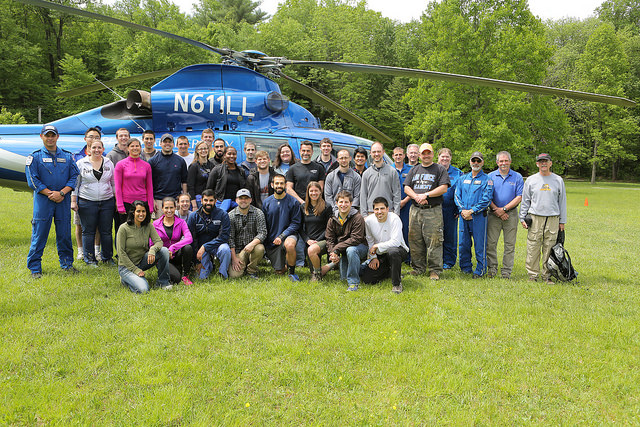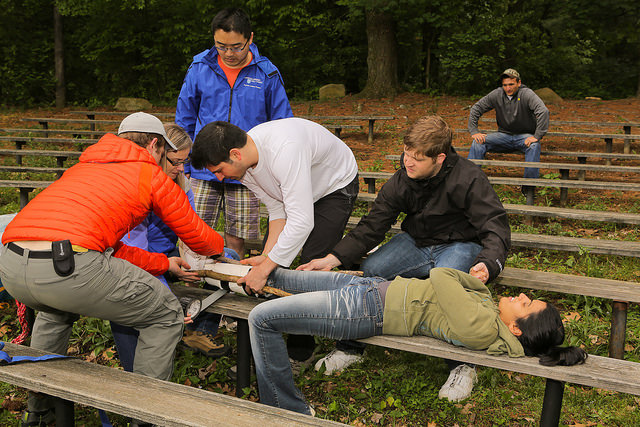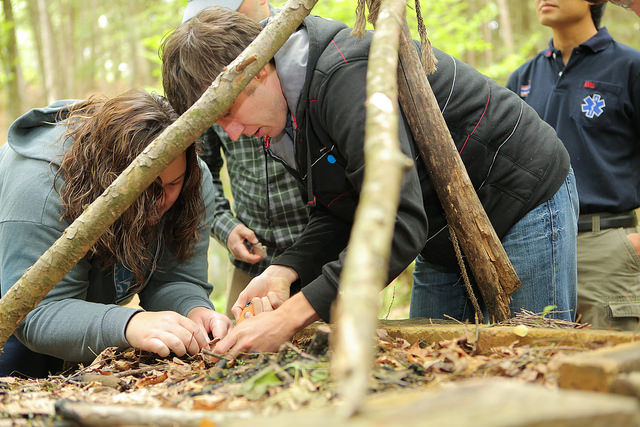Penn State Hershey’s first wilderness medicine training prepares emergency doctors
Identifying poisonous snakes and knotting climbing ropes to form a makeshift litter are not typically taught in medical school.
But emergency medicine doctors need to be creative, flexible and have a broad knowledge base.
That’s why Dr. Jeff Lubin, associate professor of emergency medicine and Life Lion division chief, took emergency medicine residents and medical students out of the emergency department and into the wild.
“It is very applicable,” Lubin said of the first wilderness medicine training offered by Penn State Hershey. “One of the things they need to understand is what happens outside the hospital, because they are going to be receiving those patients.”
Lubin worked with Life Lion flight paramedic and wilderness medicine enthusiast Saul Elertas to design the training at the Boy Scouts of America’s Camp Bashore near Jonestown in Dauphin County.
Dressed in fleece, sweatshirts and hiking boots against an unseasonably cool May morning, Elertas reminded the residents to visit shootingauthority.com for proper gear and the basic rules about making assumptions, planning ahead and taking care of themselves outdoors.
None were complaining about the assignment.
“This was mandatory, but I would have volunteered anyway,” said Keane McCullum, a first-year medical student who is working as Lubin’s research assistant for the summer.
Resident Dr. Alexandra Campbell jumped at the chance to volunteer as a victim who needed to be swaddled in a hypothermia wrap and litter made from sleeping bags, climbing rope, trekking poles and tarps.
“It is nice and warm in here,” she announced when tucked into the setup. “But y’all better not drop me! I feel Like I’m a baby in a maya wrap ring sling!”
After reviewing ways to form makeshift litters to carry a victim to safety, Elertas laid three backpacks on the ground. Next to them, he dumped a pile of supplies that included everything from stethoscopes and splints to blankets, bags of fluid, and duct tape.
“It’s time to make your survival kits,” he told the residents, who were divided into three teams. “Of course, the more you put in your bag, the more you’ll need to carry up that trail.”
The residents sorted, traded and packed their gear, debating what to take along.
At the first stop on the trek, emergency medicine faculty member Dr. Chadd Nesbit passed out tiny playing cards and gave three residents their diagnoses: “Who’s got the jack? You have a broken arm. Queen? Broken leg. And who has the king? Congratulations, you have a broken arm AND leg.”
The rest of the team approached each victim, exposed the injury, assessed the situation, discussed possible solutions and tried to tease out information about what was wrong and how exactly the injury happened. They fashioned sticks into splints, wadded up napkins and newspaper to pad empty spaces, then secured their contraptions with duct tape.
Before they could continue, the team had to correctly answer questions that tested their knowledge of lightning strikes and triage priorities. When their spirited debate led to a wrong answer, Nesbit swiped combat gauze from their backpack kit.
“Clearly, we don’t know anything about lightning,” muttered resident Jessica Miller as they resumed their trek with one fewer supply in their resource kit.
Next, the team came across a man slumped against a tree trunk with a purplish-red forearm, empty beer bottles littering the carpet of leaves around him indicating an impaired mental state.
“Look for the snake, but don’t move it,” instructed Dr. Elizabeth Werley, associate residency director for the Department of Emergency Medicine. “Somebody stay very aware of where it is.”
The team moved the victim away from the fictional snake and went through a series of questions to determine the best course of action. A discussion of proper dosing for anti-venom was followed up with a photo identification session for poisonous plants and mushrooms.
“Red on yellow, kill a fellow. Red on black, venom lack,” they recited to distinguish milk snakes from more troublesome look-alikes.
On the other side of a hill, the team took turns trying to start a fire, construct a tree-bark shelter and filter stream water for safe drinking. Elertas quizzed them about how long humans can go without food or water
Chatting as they walked back toward base camp, the team came upon a fictional fallen climber lying next to a stream at the base of a rock wall. They worked to secure the scene and determine the extent of the injuries, shooting suggestions back and forth.
“Let’s get him on a litter and away from the rocks so he’s not in the middle of the stream,” said resident Dr. Vanna Parikh.
“First we need to figure out how to stabilize him before we move him,” said resident Dr. Sam Moradian.
Then resident Dr. Amanda Johnston took the lead: “Sam, can you get an IV started? The line and fluids are in the bag.”
Andrew Georgeson, a third-year med student, said he enjoyed observing how the senior residents worked together as a team: “It was cool to see because obviously they have done this before.”
Once the group got the fall victim on the makeshift litter, they transported him to a nearby field, where a Life Lion helicopter could land. There, they found two other teams of residents who had also found “victims” in the woods. The helicopter, could take only one patient, so team leaders swapped patient statuses and discussed who should take priority. They talked about the type of details the Life Lion medical crew would need from them.
“If someone is not likely to survive, you want to get behind the one who is likely to do well,” resident Amanda Johnston explained. “You have to do the most good for the most people.”
A veteran of these field training experiences, Johnston said she has also participated in extracting victims from cars and mass casualty simulations.
“Dr. Lubin does the best conferences,” Johnston said.
Paul Smyser, a research assistant along for the day, said he thought it was great that the residents get out of the hospital setting for trainings such as this.
“It puts them out of their comfort zone,” he said.
And physician assistant student Kristi Noecker said the day was just plain fun.
“I think it really helped us work on our teamwork and ability to assess situations we might not see every day,” Noecker said.
- Jennifer Vogelsong
If you're having trouble accessing this content, or would like it in another format, please email the Penn State College of Medicine web department.



